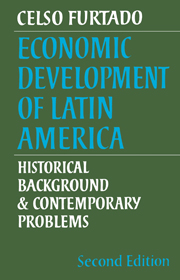Book contents
- Frontmatter
- Contents
- Tables
- Preface to the second edition
- Preface to the first edition
- Abbreviations
- Maps
- PART ONE FROM THE CONQUEST TO THE FORMATION OF NATION-STATES
- PART TWO ENTRY INTO THE SYSTEM OF INTERNATIONAL DIVISION OF LABOUR
- 4 The transformation of international trade in the second half of the nineteenth century and its impact on Latin America
- 5 Reorientation of the international economy in the present century
- 6 Some indicators of the degree of development reached in Latin America
- PART THREE THE TRADITIONAL STRUCTURAL PATTERN
- PART FOUR CHARACTERISTICS OF THE INDUSTRIALISATION PROCESS
- PART FIVE REORIENTATION OF DEVELOPMENT IN THE RECENT PERIOD
- PART SIX INTERNATIONAL RELATIONS
- PART SEVEN INTRA-REGIONAL RELATIONS
- PART EIGHT STRUCTURAL RECONSTRUCTION POLICIES
- Bibliography
- Index
4 - The transformation of international trade in the second half of the nineteenth century and its impact on Latin America
Published online by Cambridge University Press: 25 January 2010
- Frontmatter
- Contents
- Tables
- Preface to the second edition
- Preface to the first edition
- Abbreviations
- Maps
- PART ONE FROM THE CONQUEST TO THE FORMATION OF NATION-STATES
- PART TWO ENTRY INTO THE SYSTEM OF INTERNATIONAL DIVISION OF LABOUR
- 4 The transformation of international trade in the second half of the nineteenth century and its impact on Latin America
- 5 Reorientation of the international economy in the present century
- 6 Some indicators of the degree of development reached in Latin America
- PART THREE THE TRADITIONAL STRUCTURAL PATTERN
- PART FOUR CHARACTERISTICS OF THE INDUSTRIALISATION PROCESS
- PART FIVE REORIENTATION OF DEVELOPMENT IN THE RECENT PERIOD
- PART SIX INTERNATIONAL RELATIONS
- PART SEVEN INTRA-REGIONAL RELATIONS
- PART EIGHT STRUCTURAL RECONSTRUCTION POLICIES
- Bibliography
- Index
Summary
International division of labour
During the first half of the nineteenth century, the Industrial Revolution was essentially an English phenomenon. For this reason the structural evolution of the English economy provides the key to the radical changes which took place during this period in the world economy as a whole. The economists who witnessed the beginnings of these changes, and interpreted them from the English viewpoint, immediately realised that it was in England's interests to become a vast factory, opening its doors to primary products from all over the world. In fact, industrial activity, violating the law of diminishing returns, signified unprecedented qualitative change.
In economies in which technology had made little or no progress – based essentially on agricultural activity – it was evident that there were limits to the degree to which the relative proportions of the productive factors employed could be altered. Beyond a certain point, the output obtained per unit of agricultural land necessarily tended to decrease, regardless of the amount of labour added, which meant that availability of land governed the use of the other factors. Industrial activity made it possible to break this barrier, since growth itself, by creating the possibility of further specialisation in labour and equipment (greater division of labour, additional and more complex machinery), became the source of increased productivity, which meant increasing returns. In such circumstances, even if prices of imported agricultural products remained stable and were the same as those of home-produced goods.
- Type
- Chapter
- Information
- Economic Development of Latin AmericaHistorical Background and Contemporary Problems, pp. 42 - 49Publisher: Cambridge University PressPrint publication year: 1977



